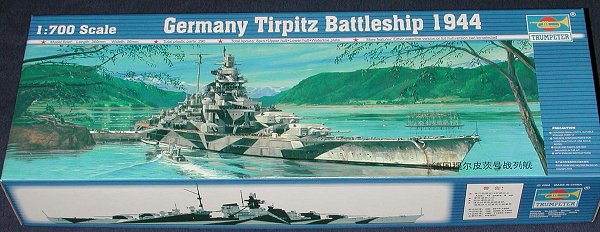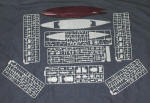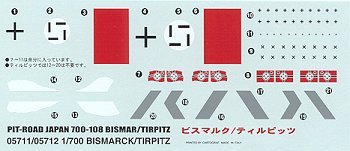
| KIT: | Trumpeter 1/700 DKM 'Tirpitz'; 1944 |
| KIT #: | 5712 |
| PRICE: | $22.95 MSRP |
| DECALS: | One option |
| REVIEWER: | Scott Van Aken |
| NOTES: | Can be built full hull or waterline |

| HISTORY |
Tirpitz, a 44,755-ton Bismarck class battleship, was built at Wilhelmshaven, Germany. Commissioned in February 1941, she operated in the Baltic during her first several months of service, conducting trials and training, as well as combat missions in connection with the invasion of the Soviet Union.
In January 1942, Tirpitz steamed to Norwegian waters, where she remained for the remainder of her career. Initially based at Trondheim, and later in fjords further north, she was a constant threat to supply lines between the Western Allies and the Soviets. Though Tirpitz never actually came into contact with Allied shipping, and only fired her guns at enemy targets during a September 1943 raid on shore facilities at Spitzbergen, her great power caused the U.S. and British navies to divert scarce resources to counter her and generated intense efforts to put her out of action.
In late September 1943, a British midget submarine raid planted explosives near Tirpitz, causing serious shock damage when they exploded. In February 1944, while she was under repair, the German battleship was the target of a raid by Soviet bombers that produced one near-miss. In early April, as her repairs were completing, Tirpitz was attacked by British carrier-based planes, receiving several hits and serious damage and casualties. Further repairs lasted until June, and she was again attacked by British planes in July and August, though the resulting damage was not serious. In mid-September, she was hit in the bow by very heavy bombs dropped by Royal Air Force heavy bombers. Moved to Tromsų in October, she was the target of further raids. Finally, on 12 November, Tirpitz was hit and near-missed by several very heavy bombs, causing massive damage. She listed heavily, suffered an ammunition explosion and rolled over. Her wreck was largely scrapped in place after the war.
| THE KIT |
 Once
you are able to pry open Trumpeter's usual think, sturdy box, you are
greeted by several bags of sprues. One contains the upper and lower hull
while others contain the various sprues. There are no more than two sprues
per bag and that keeps the bits from breaking off. A good thing, too as
there are nearly 300 of them. Yep, nearly 300 so this isn't your
grandfather's waterline kit. This baby is detailed!
Once
you are able to pry open Trumpeter's usual think, sturdy box, you are
greeted by several bags of sprues. One contains the upper and lower hull
while others contain the various sprues. There are no more than two sprues
per bag and that keeps the bits from breaking off. A good thing, too as
there are nearly 300 of them. Yep, nearly 300 so this isn't your
grandfather's waterline kit. This baby is detailed!
Parts are flash free, sink area free and have no ejector pin marks that would be visible when the kit is finished. At least, I certainly didn't see any. The detailing is really superb with all you could ask for in a modern waterline kit. All the deck pinnings are there as is the proper detailing for the superstructure. The kit can be built either as a waterline or as a full hulled model. For those who might be wondering, it appears that there are blast bags on the base of the barrels where they fit into the turrets. You also have to drill out a few holes for the additional anti-aircraft guns that the Tirpitz carried. It also appears that you can do a couple of searchlight positions with covers over them.
 Instructions are most
detailed and provide14 construction steps. All are well drawn and provide
indications of which small subassemblies go where. No color info is
provided during the construction phase. Since this is the Tirpitz as it was
in 1944, it has a rather complicated camouflage scheme. Colors are provided
and FS 595 approximations are also given. I haven't a clue as to whose
paints are being referenced. A few of the camo bits are provided as decals.
This includes the red fore and aft square that includes a swastika. There
is some discussion as to whether this was actually carried, but it is there
in case you want to put it on. There are even decals for the float plane.
The decals are very well printed by Cartograf and designed by Pit
Road, which leads me to think that perhaps this kit has been designed by
them as well, but I know little of ship kit ancestry to be sure.
Instructions are most
detailed and provide14 construction steps. All are well drawn and provide
indications of which small subassemblies go where. No color info is
provided during the construction phase. Since this is the Tirpitz as it was
in 1944, it has a rather complicated camouflage scheme. Colors are provided
and FS 595 approximations are also given. I haven't a clue as to whose
paints are being referenced. A few of the camo bits are provided as decals.
This includes the red fore and aft square that includes a swastika. There
is some discussion as to whether this was actually carried, but it is there
in case you want to put it on. There are even decals for the float plane.
The decals are very well printed by Cartograf and designed by Pit
Road, which leads me to think that perhaps this kit has been designed by
them as well, but I know little of ship kit ancestry to be sure.
| CONCLUSIONS |
Bottom line is that this is one heck of a kit. It should satisfy the detail freaks out there and it is really a great value as similar kits by Japanese kit makers are running well over twice this price.
| REFERENCES |
Thanks to Stevens International for the review kit.
If you would like your product reviewed fairly and quickly by a site that has over 250,000 visitors a month, please contact me or see other details in the Note to Contributors.